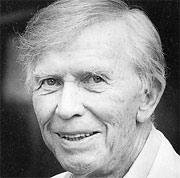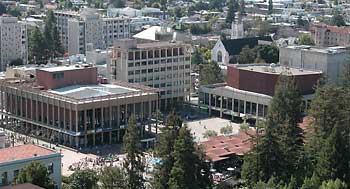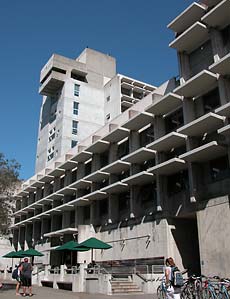UC Berkeley Press Release
Noted architect Vernon DeMars dies at age 97
BERKELEY – Vernon DeMars, a professor emeritus of architecture at the University of California, Berkeley, and a co-designer of Wurster Hall, home of the College of Environmental Design, and of the award-winning student center complex on campus, died Friday (April 29) following a stroke. He was 97.
 Vernon DeMars |
"He was just a wonderful humanist and an innovative thinker," said Harrison Fraker, dean of UC Berkeley's College of Environmental Design, calling DeMars one of the most important post-war modernist architects.
The San Francisco-born DeMars served as chief of the housing standards section of the National Housing Agency during World War II and collaborated on low-income housing for migrant farm workers in the western states. He also helped design rural housing, schools, clinics, temporary housing for war workers, dormitories and community centers.
From 1945-1946, DeMars was a lieutenant in the U.S. Navy and worked as an aid to the governor of Puerto Rico and as an advisor on housing problems.
He helped to design Easter Hill Village, a public housing project in Richmond that in the 1950s was considered cutting-edge for its mix of subsidized and market-rate housing in the form of variously colored, one-and two-story townhomes built around gardens and cul-de-sacs.
DeMars also designed the Golden Gateway Redevelopment Project along San Francisco's Embarcadero, Capitol Towers apartments in downtown Sacramento, and Mililani, Oahu's first planned community.
He designed his own home in the Berkeley hills, where he and his wife, the late Betty Bates DeMars, lived for years. She was an artist and costume designer known for creating the huge banners that still adorn the lobby of Zellerbach Hall on campus.
 Among DeMars' landmark campus designs is the 1959 student center complex, which surrounded Lower Sproul Plaza with (clockwise from left) Martin Luther King Jr. Student Union, Eshleman Hall, Zellerbach Hall and Cesar E. Chavez Student Center. (Steve McConnell photo) |
The hall is part of UC Berkeley's student center complex - including Eshleman Hall, Martin Luther King Jr. Student Union, Cesar E. Chavez Student Center and Upper and Lower Sproul plazas - that her husband designed with fellow architect Donald Hardison, along with landscape architect Lawrence Halprin, in 1959.
In 1978, DeMars and Hardison received the Award of Honor for Design Excellence from the Bay Area chapters of the American Institute of Architects, which saluted the Zellerbach Hall/student center area design for being "in the tradition of the great European urban plazas and spaces."
"His buildings fit so gracefully with the activities they were serving, but with a fresh and contemporary sensibility," said Fraker, noting that Zellerbach Hall is still one of the best performing spaces on any college campus, and that the rooms of the student center are "fresh and wonderful spaces to be in."
DeMars was among the founders in September 1939 of a collective of San Francisco planners, landscape architects and architects promoting "progress intelligently planned."
"Products of the Depression, stimulated by the potentials of new technology and aware that all was not well in the world at large, we had singled out the betterment of the physical environment and its social purposes as our mutual goal," Francis Violich, a UC Berkeley professor emeritus of city and regional planning and landscape architecture, recalled about the early days of that collective, Telesis, in a working paper a few years ago.
The Telesis Environmental Group officially worked for 14 years to shape San Francisco and the Bay Area, but its influence continues.
When the American Institute of Architects' California Council honored DeMars with a lifetime achievement award for distinguished service in 2003, it observed that Telesis was the inspiration for today's San Francisco Planning and Urban Research Association, a public-policy think tank that promotes good planning and good government.
The council continued with its commendation of DeMars' contributions: "Sharing a boundless energy, communal spirit and collaborative exploration of everything imaginable, of 'planned chaos,' your belief of variety in modern design and accidental urban spaces has formed exciting communal areas for the public to utilize and enjoy."
DeMars' studies, in the Beaux Arts tradition, began just as John Galen Howard retired as campus architect and head of UC Berkeley's architecture department. DeMars earned a bachelor's degree in architecture at UC Berkeley in 1931 and continued for a year, doing graduate work in design.
While working as a visiting professor of architecture at the Massachusetts Institute of Technology (MIT) from 1947-1949, DeMars co-directed a student research project that led to a 12-story faculty housing project that at the time Architectural Record magazine called one of the 50 most significant buildings in the United States over the past century.
 DeMars was one of the designers of Wurster Hall, a Brutalist modern classic that is home to the College of Environmental Design. (Steve McConnell photo) |
While at MIT, DeMars met William Wurster, dean of MIT's School of Architecture. A few years later, both reunited at UC Berkeley, where DeMars became a professor and Wurster became dean of the architecture school. The two were instrumental in establishing UC Berkeley's College of Environmental Design, the first in the country to bring together the various design professions -- architecture, city and regional planning, and landscape architecture -- under one aegis.
Wurster was the first dean of the new college and selected architects DeMars, Joseph Esherick and Donald Olsen to create a schematic design for the building that later was named in honor of Wurster and his wife, planner Catherine Bauer Wurster. The Brutalist modernist, cast concrete structure built in 1964 features a three-story base with a 10-story tower.
DeMars, who served as chair of the architecture department from 1959 to 1962, theorized that he and Esherick were chosen for because of their different degrees of humanistic leanings, and Olsen for a formal perspective that would balance out the design.
Mike Martin, chair of UC Berkeley's architecture department, noted that DeMars had a major impact on the department, the campus and architectural education around the globe as he took design aesthetics and technology "to a new level."
For years before the Loma Prieta earthquake in 1989, DeMars lobbied for demolition of the Embarcadero Freeway in San Francisco and for building underground boulevards and parking places to enable construction of a neo-classical piazza in front of the Ferry Building.
"It was always nice to see that he had a crusade," recalled Fraker.
During his career, DeMars was a member of several architectural firms. He belonged to the Regional Planning Council of America and the American Society of Planners and Architects.
Upon his retirement in 1975, DeMars received the Berkeley Citation, the campus's top honor, and in 1999 he was honored as a distinguished alumnus by the College of Environmental Design and the CED Alumni Association.
DeMars died at Summit Medical Center in Oakland. He leaves no immediate family.
A campus memorial service for DeMars will be announced later. Contributions in his memory can be made to the UC Berkeley College of Environmental Design, with checks made to "The College of Environmental Design" with a note in the memo line: "In honor of Vernon DeMars." Checks can be sent to: Lawrence Lawler, College Relations, College of Environmental Design, UC Berkeley, 235 Wurster Hall, MC 1820, Berkeley, CA 94720-1820.

